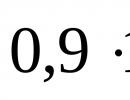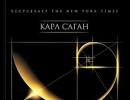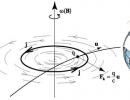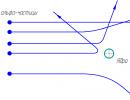Location of cartographic images of the earth's surface. Cartographic projections and distortions on maps. Main types of projections
Since ancient times, man has had a need to convey information to other people about where he was and what he saw. Today there are different types of images of the earth's surface. All of them are small models of the world around us.
Cartography
Images of the earth's surface appeared earlier than writing. Ancient people used mammoth tusk, stone or wood for the first sketches of the area. In the Ancient world, images were made on papyrus and cloth, and later on parchment. The first mapmakers were true artists, and maps were works of art. Ancient maps resemble fairy-tale paintings depicting unknown countries and their inhabitants. In the Middle Ages, paper and the printing press appeared, which made it possible to establish mass production of cards. Map creators collected information about the Earth from the words of numerous travelers. The content of the cards became more and more diverse. The science of maps as a special way of depicting the earth's surface, their creation and use is called cartography.
Globe - model of the Earth
The ancient Greeks were the first to prove that the Earth is spherical. To correctly display the shape of the Earth, a globe was invented. A globe (from the Latin word globe - ball) is a three-dimensional model of the planet, reduced many millions of times. There are no surface distortions, so with its help they get a correct idea of the location of continents, seas, oceans, and islands. But the globe is much smaller than the Earth, and it is impossible to show any terrain in detail. It is also inconvenient to use while traveling.
Plan and map
A plan is a drawing on which a small area of terrain is depicted in detail in a reduced form using conventional symbols, so there is no need to take into account the curvature of the earth's surface.
A map is a generalized reduced image of the earth's surface on a plane using a system.
Geographic maps have important properties. In contrast to plans, they depict different areas of coverage - from small areas of the earth's surface to continents, oceans and the globe as a whole. When displaying the convex surface of the Earth on a flat sheet of paper, distortions inevitably arise in the image of its individual parts. However, maps allow you to measure distances and determine the size of objects. They contain information about the properties of objects. For example, about the height of mountains and the depth of seas, the composition of flora and fauna.
Atlases - collections of maps
An important step in the development of geographical images was the creation of atlases of map collections. These are real cartographic encyclopedias. It is believed that the first collection of maps appeared in the Roman Empire. Later, in the 16th century, the very concept of “atlas” was introduced. Geographical atlases are very diverse in territorial coverage: world atlases, atlases
individual countries, regions and cities. According to their purpose, atlases are divided into educational, local history, road and others.
Aerospace images
Progress in aviation and astronautics has allowed man to photograph the Earth. Aerial photographs and satellite images provide detailed images of all the details of the area. But the geographical objects on them have an unusual appearance for us. Recognition of images in photographs is called decoding.
Today we increasingly use maps on a computer monitor or mobile phone screen. They are created on the basis of satellite images using special computer programs.
The surface of the globe cannot be depicted on a plane without distortion. Only on a spherical globe can the similarity and proportionality of the sizes of all parts of the earth's surface be preserved. But globes are inconvenient to use, and their scale is usually not large, for example, at a scale of 1 km by 1 cm (1: 100,000), the diameter of the globe would be 127.4 m.
There are various ways to depict the earth's surface on a plane. All of them are called map projections. Some of them are actually obtained by projecting the earth's surface onto a plane with rays emanating from a constant point of view located outside, on or inside the globe, others have a different geometric meaning. Each of these methods indicates a very specific method for depicting the earth's surface on a plane and taking into account inevitable distortions.
However, if you take an ordinary school globe of 1:50,000,000 scale (the diameter of which is about 25 cm) and pin a small piece of paper 1 cm2 in size to its surface, it will turn out that without folds it almost completely coincides with the surface of the globe. This shows that in small areas we can consider the earth's surface to be flat and depict it on paper while maintaining the geometric similarity of the figures. Such images are often called plans. The use of projections loses its significance here, since even in different, but properly selected, projections, images of very small areas of the globe hardly differ from each other.
When considering cartographic projections, the image on the plane of the earth's surface is practically replaced by the image on the plane of a geographic grid of meridians and parallels, which on the map is called a cartographic grid. This is permissible because, having built meridians and parallels on the map, we can plot any point according to its geographical coordinates. Therefore, in the following presentation we are talking about a grid of meridians and parallels on the “mathematical surface” of the earth, for which we take the surface of the oceans, mentally continued under the continents, and about the image of this grid on a plane. For some projections, map grids are constructed geometrically, but more often a different technique is used. First, the flat rectangular coordinates of the points of intersection of the meridians and parallels are calculated using the available formulas of the selected projection, then these points are placed on paper using the coordinates and then connected with smooth curved lines depicting the meridians and parallels.
Each conventional image of the earth's surface on a plane, i.e. each projection, corresponds to a very specific type of cartographic grid and very specific permissible distortions. Distortions of lengths, areas and angles are distinguished.
It is known that on the earth's surface all meridians have the same length; Segments of the same parallel between adjacent meridians are also equal to each other. But only the middle meridian is depicted as a straight line; the remaining meridians are curved lines, the length of which increases with distance from the middle meridian. Parallels are also distorted to the same extent - their segments between neighboring meridians increase with distance from the middle meridian.
There are other projections that do not distort lengths along certain well-defined directions. For example, equidistant cylindrical. The meridians are shown on it without distortion, since the lengths of the meridians on the grid are equal to the lengths of the meridians in nature, of course, reduced to the scale of the map. But the lengths of the parallels in this projection are distorted. On a grid, the segments of parallels between two neighboring meridians remain constant at any latitude, whereas in reality they decrease as they approach the poles.
The expression “distortion of lengths” means that lengths are transmitted on the same map with different reductions, that is, at different scales in different places on the map. In other words, the scale on the same map does not represent a constant value; it can change not only at different points, but even at one point in different directions.
The scale that is signed on the map is called the main one; it determines the ratio of the lengths on the map to the corresponding lengths in nature only in some parts of the map, defined for each projection. The scales in its remaining parts are larger or smaller than the main one and are called private.
Such a projection, which would convey any lengths in any direction without distortion, is impossible, since it would preserve the similarity and proportionality of all parts of the earth's surface, which can only occur on a globe.
Area distortions can be seen in the same figures. The surfaces of cells located between two adjacent parallels are naturally the same size, but they increase noticeably to the east and west of the middle meridian. The surfaces of cells bounded by two meridians naturally decrease to the north and south of the equator; but they are all the same size.
However, there are numerous projections on which the sizes of surfaces are conveyed without distortion; all areas on such maps are proportional to the sizes of the corresponding surfaces in nature, although the similarity of the figures is broken. Such projections are called equal area, equal area or equivalent.

Meridians and parallels that form right angles with each other in nature retain perpendicularity only along the middle meridian. On the contrary, the map grid is free from angular distortion. Such projections that preserve the magnitude of the angles are called equiangular or conformal. Around each point of a conformal projection at infinitesimal distances, the scale can be considered constant.
There are many projections that are neither equal-area nor equiangular (they are called arbitrary), but there is no one that combines both qualities.
___________
You can familiarize yourself with the basic principles of diagnosis, prevention and treatment of such a serious joint disease as osteoarthritis (or arthrosis) on the website spina.net.ua, which is dedicated to diseases of the spine.
Lesson topic: Topographic map.
Lesson type: combined
Lesson date:
Educational resources multimedia presentation, physical map of Russia, topographic map
Lesson plan: 1. What is a topographic map. 2. What is the purpose of this. 3. About the features of this. 4. What is magnetic declination. 5. How
navigate using a topographic map.
Purpose: to study the features of the topographic map.
Lesson objectives. 1. Create pedagogical conditions for students under which they can:
name the distinctive features of topographic maps; explain methods for determining distances, azimuths, directions using topographic
map; use various instruments (protractor, ruler) to determine distances and azimuths on a topographic map; explain differences
geographic and magnetic poles of the Earth; explain the need to determine magnetic declination and magnetic azimuth; carry out comprehensive
analysis of geographical conditions for conducting business activities using a topographic map.
2. Develop navigation skills using a topographic map. 3. Form subject and meta-subject learning activities again
thematic content of the lesson.
Basic terms and concepts azimuth, terrain profile, scale, magnetic azimuth, magnetic declination, compass, orientation, geographic
pole, magnetic pole.
Planned results:
Personal: developing the ability to independently acquire new knowledge and practical skills using a terrain plan.
Meta-subject: formation and development through geographical knowledge of cognitive interests, intellectual and creative abilities.
Subject: determine the scale on a plan, map; convert scale from one view to another; make measurements on the plan and simple calculations;
read a topographic plan using symbols.
Lesson stage
Organizational
moment
Update
knowledge
Definition
lesson topics
Teacher activities
Organization for the lesson. Greeting students, checking
readiness to study for the lesson.
Student activities
Greeting the teacher, preparing for the lesson.
Organizational structure of the lesson
1. Test on the topic “Map and its mathematical basis”
2. Individual cards (application)
3. Retelling
The board presents physical maps of Russia and
topographical.
what types of cards do you see on the board?
Which map is easier to calculate the scale and find the azimuth?
You will learn the definition of lesson objectives. eleven
Demonstrate knowledge of the material covered.
Answers: 1a, 2d, 3c, 4a, 5b, 6) 1d, 2c, 3b, 4a 7) b, d, e 8) c, b, d, a
Answer questions and determine the topic of the lesson.
Write down the topic of the lesson in your notebook

Studying
new topic
Primary
comprehension and
consolidation
Lesson summary.
Reflection
Problematic question p.11
We begin studying new material by analyzing the key
words according to the content of the paragraph.
Explanation. Reading a topo map using conditionals
signs using the example of a topo map, atlas and textbook.
Dynamic pause
Write down definitions and give examples
Completing practical tasks:
Perform other tasks. Answers
1. Write down the numerical scale if the terrain is on it
reduced by 200 times.
2. Write down the numerical scale if the terrain is on it
reduced by 200 times.
3. How many times is the distance on the plan reduced if
scale: 1: 100 1:500 1:100000
4. The length of the road between cities is 2400 km. How long
you will get a line depicting this highway on the map,
made on a scale: a) 1:100,000,000; b) 1:200,000,000?
Give your answer in millimeters.
K. p. Using a topographic map of an atlas or textbook,
complete the tasks and answer the questions.
1. Calculate the azimuth of the direction from the city of Odintsovo to the city
Ivanovo.
2. Determine on the map the distance from the city of Odintsovo to the city
Ivanovo.
3. Moving from Odintsovo to Ivanovo, we climb up the
uphill or down?
Did we complete the assigned tasks in the lesson?
Questions to reproduce knowledge
1. What maps are called topographic?
2. What is orientation?
3. What is azimuth?
4. What types of azimuths are there?
5. What is magnetic declination?
1. 1:200
2. In 1 cm 2 m
3. In 100, 500, 100000
4. 1cm 100000000cm = 1000km
X cm 2400 km X = 2400: 1000 = 2.4 (cm)
1cm 200000000cm = 2000km
X cm 2400km X = 2400: 2000 = 1.2(cm)
5.
6.
Summarize using the example
Homemade
exercise
§2 retelling, answer questions. p.16
Write down D/Z

named and vice versa.
Named in numeric:
In 1 cm 110 m =
In 1 cm 15 m =
In 1 cm 200 m =
In 1 cm 5 km =
In 1 cm 400 km =
Numeric to named:
1: 200 000=
1: 9 000 000 =
1: 130 000 =
1: 50 000 000=
1: 25 000 000=
A) determine by scale
distances between cities:
Moscow Murmansk
Krasnoyarsk – Yakutsk
Penza Tula
1) Convert the scale from numerical to
named and vice versa.
Named in numeric:
In 1 cm 110 m =
In 1 cm 15 m =
In 1 cm 200 m =
In 1 cm 5 km =
In 1 cm 400 km =
Numeric to named:
1: 200 000=
1: 9 000 000 =
1: 130 000 =
1: 50 000 000=
1: 25 000 000=
2) Determine the distances on the map.
A) determine by scale
distances between cities:
Moscow Murmansk
Krasnoyarsk – Yakutsk
Penza Tula
1) Convert the scale from numerical to
named and vice versa.
Named in numeric:
In 1 cm 110 m =
In 1 cm 15 m =
In 1 cm 200 m =
Numeric to named:
1: 200 000=
1: 9 000 000 =
1: 130 000 =
2) Determine the distances on the map.
A) determine by scale
distances between cities:
Moscow Murmansk
Krasnoyarsk – Yakutsk
Penza Tula
2) Determine the distances on the map.
distances between cities:
region)
Vologda Rostov-Don
Saratov Irkutsk
2) Determine the distances on the map.
B) determine in degrees and kilometers
distances between cities:
St. Petersburg Serov (Sverdlovsk
region)
Vologda Rostov-Don
Saratov Irkutsk
2) Determine the distances on the map.
B) determine in degrees and kilometers
distances between cities:
St. Petersburg Serov (Sverdlovsk
region)
Vologda Rostov-Don
Saratov Irkutsk

In 1 cm 5 km =
In 1 cm 400 km =
1: 50 000 000=
1: 25 000 000=

Application.
1. Which of the listed projections is usually used when constructing maps of the territory of Russia?
a) conical; b) oblique azimuthal; c) normal azimuthal; d) cylindrical.
3. On which of the listed cards will the size of distortion be the smallest? a) map of the Eastern Hemisphere;
b) map of Eurasia; c) map of the Crimean peninsula; d) physical map of the world.
4. In which of the listed projections there are no distortions along the parallel of contact between the cone and the ball? A)
conical; b) oblique azimuthal; c) normal azimuthal; d) transverse azimuthal.
distortions. 2) There are no corner distortions on navigation maps. A)
Only the 1st statement is true; b) only the 2nd statement is true; c) both statements are true; d) both
the statements are wrong.
Numerical scale
1) 1:5000
2) 1:50000
3) 1:5000000
4) 1:50000000
1
Named scale
A) 1 cm 500 km
B) 1 cm 50 km
B) 1 cm 500 m
D) 1 cm 50 m
3
4
2
7. For which three of the listed countries of the world is the best cartographic projection of their image?
will it be conical? Write the answer as a sequence of letters in alphabetical order. A)
Indonesia; b) Canada; c) Kenya; d) Russia; e) USA; e) Ecuador
8. Arrange cartographic images of the earth's surface as their scale decreases. A)
Moscow city plan; b) physical map of Eurasia; c) physical map of the world; d) physical map
Russia.
§ 1. Map and its mathematical basis.
1. Which of the following projections is usually used when constructing maps of the territory
Russia? a) conical; b) oblique azimuthal; c) normal azimuthal; d) cylindrical.
2. In which of the listed projections there are no distortions along the equator line? a) azimuthal; b)
conical; c) polyconical; d) cylindrical.
3. On which of the listed cards will the size of distortion be the smallest? a) map of Vostochny
hemispheres; b) map of Eurasia; c) map of the Crimean peninsula; d) physical map of the world.
4. In which of the listed projections there are no distortions along the parallel of contact between the cone and the ball?
a) conical; b) oblique azimuthal; c) normal azimuthal; d) transverse azimuthal.
5. Are the following statements true? 1) The larger the scale of the map, the larger the value on it
distortions. 2) There are no corner distortions on navigation maps.
a) only the 1st statement is true; b) only the 2nd statement is true; c) both statements are true; G)
both statements are wrong.
6. Establish a correspondence between the numerical scale and the corresponding named scale.
Numerical scale
5) 1:5000
6) 1:50000
7) 1:5000000
8) 1:50000000
Named scale
A) 1 cm 500 km
B) 1 cm 50 km
B) 1 cm 500 m
D) 1 cm 50 m
4
7. For which three of the listed countries of the world do they have the best cartographic projection?
1
2
3
will the image be conical? Write the answer as a sequence of letters in alphabetical order
ok. a) Indonesia; b) Canada; c) Kenya; d) Russia; e) USA; e) Ecuador
Lesson #7
I option
The founder of the science of geography is:
a) Herodotus; b) Eratosthenes; c) Aristotle.
Geography as a science first appeared in:
a) Ancient Egypt; b) Ancient Greece; c) Ancient Rome.
The main method for determining the size of the earth's surface is:
a) cartographic; b) descriptive; c) cosmic.
The science of creating and using maps is called:
a) geography; b) cartography; c) topography.
The circumference of the globe is:
a) 39,690 km; b) 40,000 km; c) 40,075 km.
The equator is:
a) a line passing through the poles of the planet
b) a line that divides the earth's surface in half and is located on
equal distance from the poles
c) a line passing through any two points on the earth’s surface
Match the concepts and its definition:
EARTH RADIUS DEFINITION
1) equatorial radius a) the distance from the center of the planet to the equator
2) polar radius b) distance from the center of the planet to the poles
Which statement characterizes the globe?
a) gives an idea of the shape of the Earth;
b) does not give a correct idea of the size of geographical objects;
C) does not give a correct idea of the shape of the Earth.
Establish a correspondence between the image of the earth's surface and the image method.
IMAGE IMAGE METHOD
1) flat image a) map
2) three-dimensional image b) globe
B) area plan
Continents, oceans, islands and other geographical objects are depicted on the map and globe:
a) enlarged;
b) in a reduced form;
c) without changing dimensions.
The orientation device is called:
a) thermometer; b) compass; c) barometer.
What color corresponds to the end of the compass needle indicating the direction north:
a) white; b) red; c) blue.
The direction between north and west is called:
a) northeast; c) southwest;
b) northwest; d) southeast.
The first compass appeared:
a) in India; b) in Russia; c) in China.
Establish a correspondence between the types of sides of the horizon and their names:
VIEW OF HORIZON SIDES HORIZON SIDES
main sides of the horizon a) north
intermediate sides of the horizon b) northeast
B) northwest
D) south
D) southwest
16. Which ancient scientist calculated the size of the globe?
17. How does the axial motion of the Earth differ from orbital motion?
18. What is indicated by shades of blue on a geographical map?
Test on the topic: “The Earth and its image”
II option
Geography as a science originated in:
A)Icentury BC b)IIcentury BC V)IIIcentury BC
At the beginning of its development, geography had
a) descriptive meaning; b) scientific significance; c) measured value.
Arrange the methods of geographical research in chronological order (according to the time of their origin from the most ancient to the most modern):
a) descriptive; b) cartographic; c) cosmic.
An example of a cartographic source of geographic knowledge is:
a) an album of photographic images;
b) scientific article;
c) atlas.
The length of the equator is:
a) 40,000 km; b) 39,690 km; c) 40,075 km.
The equator divides the Earth into hemispheres:
a) northern and western; c) western and eastern;
b) eastern and southern; d) northern and southern.
Match:
TYPE OF MOVEMENT DESCRIPTION OF MOVEMENT
axial motion a) the movement of the earth around the sun
orbital motion b) the movement of the Earth around its axis
Choose the correct expression characterizing the card:
a) flat image of the earth's surface
b) has no distortion
c) gives an idea of the shape of the Earth
Match the color used on the physical map to its meaning.
COLOR UNEVENness OF THE GROUND SURFACE
yellow a) mountains
green b) low plains
brown c) raised plains
Arrange photographic images as the coverage of the area increases.
a) satellite image;
b) a photograph from the surface of the Earth;
c) aerial photograph.
Determining your position relative to the sides of the horizon is called:
a) orientation; b) leveling; c) timing.
The sun rises on:
a) north; b) east; c) west.
The direction between south and east is called:
a) northeast; b) southwest;
b) northwest; c) southeast.
A specially shaped canvas hat for sailors and fishermen is called:
a) cap; b) cap; c) southwester.
Match the directions on the sides of the horizon with their names:
DIRECTIONS OF THE HORIZONT SIDE
1 a) west
B) south
1 2 c) north
D) east
16. What evidence did Aristotle give for the sphericity of the Earth?
17. What are the two main types of motion the Earth makes?
18. What is indicated by shades of green on a geographical map?
ANSWERS
Test






